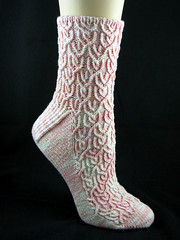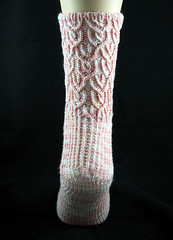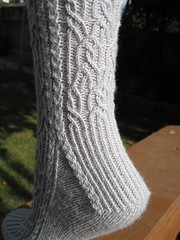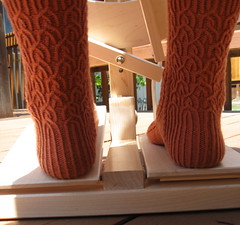Goin' for Baroque
For those who are interested in hearing how Baroque came to life, I give you the backstory.
Last year I wanted to knit a pair of socks for a friend at work. At that time I was obsessed with continuous stitch patterns like those used in Crystalline Lattice and Early Spring, stitch patterns that don't have obvious breaks as you follow the sts around the cuff. I wanted something complicated and intricate and found inspiration in a Japanese stitch pattern book. I swatched and modified until I was happy with the result.
My friend is allergic to wool, so I chose Panda Cotton in Rosewater. The shading was subtle enough so as not to detract from the pattern. The socks were worked toe-up to take advantage of every inch of yarn and finished with a tubular cast-off.

Before Baroque
Project details on Ravelry

Before Baroque
I loved how the socks looked, but they had one fatal flaw. They *just* fit my friend's feet (which are smaller than mine) and the continuous pattern that I was so enamored with didn't lend itself to be sized up easily. The pattern writing was set aside for a while.
When I revisited the design, I came to terms with abandoning the continuous stitch pattern and added a design element to the sides that would make the sock easier to knit, add interest, add stretch, and provide a means to vary the size. The continuity of design was extended vertically through the twisted st heel flap and also onto the top of the toe. If I couldn't have a continuous st pattern horizontally, I was going to take it as far as I could vertically.
The next sock was knit cuff-down in Zitron Trekking Pro Natura. I tried paired "braids" down the sides, but I wasn't thrilled with the result. The braids looked okay, but they were a lot of work and weren't that impressive. Not enough bang for the buck. The second sock was knit with cables down the sides--they were easier to execute and looked great.
Here are photos of the sock with the braids.

Almost Baroque
Project details on Ravelry

Almost Baroque
Now I had a plan for a design that would work but I needed a different yarn. The Pro Natura was on the thin side of fingering weight and you might be able to see in the photos that it had a tendency to get fuzzy. My yarn choice was made for me when I saw 2 hanks of Louet Gems in Terra Cotta at the Wool Tree in South Lake Tahoe. I had never seen that color before and knew it would be perfect.
As I worked on the 3rd and final pair, I had to come up with descriptions for how to work the twisted st cables. For those that haven't looked at the pattern details, the cables are a little different than what you might expect. The cables involve 3 sts... numbering them as they present themselves on the left needle,
st3, st2, st1
ktbl, p1, ktbl
The cable involves reversing the order of the sts--st3 is worked first, then st2, then st1. The middle st is always purled and the outside sts are ktbl.
I was working the cables without a cable needle so it wasn't that difficult to come up with a description of how to manipulate the stitches. It may sound involved in the pattern, but if you try it a few times you'll catch on to what's happening and hopefully you'll be able to get past all of the words.
Describing how to do the cables with a cable needle was a little more work. I thought the easiest thing would be to slip all 3 sts onto a cable needle then rotate the needle clockwise or counter clockwise, depending if the cable crossed to the left or the right. But describing how the sts should be worked after they were rotated was a bit of a mind bender. I pulled out my trusty worsted weight waste yarn and made a swatch, watching the orientation of each st as the cable needle was rotated and figured out if the stitch had to be re-seated, ktbl, or could be worked as-is.
The name was inspired by classical music and art. Baroque and Rococo were the top two picks, but since I was partial to Bach, Baroque won.
The indoor photos were taken on the dining room table with natural light from a window. The violin is mine and the music is Suite IV for Solo Violin by J.S. Bach. The violin and sock model were held at the proper angle by unseen hands (thanks R).

Baroque
Project details on Ravelry
The outdoor photos were a last minute add--the submit deadline was fast approaching and I didn't think I had enough variety. I took the Lendrum DT outside and started snapping away.
This one is a touch out of focus, but I love the perspective.

Baroque
For yarn alternatives, take a look at the Ravelry page to see what other people are using, or consider a yarn that uses the same/similar base yarn like Nature's Palette from Hand Jive Knits.
If you'd like to see Baroque in person, stop by Purlescence Yarns in Sunnyvale. They have a sock on display and a nice selection of Louet Gems on hand.
Last year I wanted to knit a pair of socks for a friend at work. At that time I was obsessed with continuous stitch patterns like those used in Crystalline Lattice and Early Spring, stitch patterns that don't have obvious breaks as you follow the sts around the cuff. I wanted something complicated and intricate and found inspiration in a Japanese stitch pattern book. I swatched and modified until I was happy with the result.
My friend is allergic to wool, so I chose Panda Cotton in Rosewater. The shading was subtle enough so as not to detract from the pattern. The socks were worked toe-up to take advantage of every inch of yarn and finished with a tubular cast-off.

Before Baroque
Project details on Ravelry

Before Baroque
I loved how the socks looked, but they had one fatal flaw. They *just* fit my friend's feet (which are smaller than mine) and the continuous pattern that I was so enamored with didn't lend itself to be sized up easily. The pattern writing was set aside for a while.
When I revisited the design, I came to terms with abandoning the continuous stitch pattern and added a design element to the sides that would make the sock easier to knit, add interest, add stretch, and provide a means to vary the size. The continuity of design was extended vertically through the twisted st heel flap and also onto the top of the toe. If I couldn't have a continuous st pattern horizontally, I was going to take it as far as I could vertically.
The next sock was knit cuff-down in Zitron Trekking Pro Natura. I tried paired "braids" down the sides, but I wasn't thrilled with the result. The braids looked okay, but they were a lot of work and weren't that impressive. Not enough bang for the buck. The second sock was knit with cables down the sides--they were easier to execute and looked great.
Here are photos of the sock with the braids.

Almost Baroque
Project details on Ravelry

Almost Baroque
Now I had a plan for a design that would work but I needed a different yarn. The Pro Natura was on the thin side of fingering weight and you might be able to see in the photos that it had a tendency to get fuzzy. My yarn choice was made for me when I saw 2 hanks of Louet Gems in Terra Cotta at the Wool Tree in South Lake Tahoe. I had never seen that color before and knew it would be perfect.
As I worked on the 3rd and final pair, I had to come up with descriptions for how to work the twisted st cables. For those that haven't looked at the pattern details, the cables are a little different than what you might expect. The cables involve 3 sts... numbering them as they present themselves on the left needle,
st3, st2, st1
ktbl, p1, ktbl
The cable involves reversing the order of the sts--st3 is worked first, then st2, then st1. The middle st is always purled and the outside sts are ktbl.
I was working the cables without a cable needle so it wasn't that difficult to come up with a description of how to manipulate the stitches. It may sound involved in the pattern, but if you try it a few times you'll catch on to what's happening and hopefully you'll be able to get past all of the words.
Describing how to do the cables with a cable needle was a little more work. I thought the easiest thing would be to slip all 3 sts onto a cable needle then rotate the needle clockwise or counter clockwise, depending if the cable crossed to the left or the right. But describing how the sts should be worked after they were rotated was a bit of a mind bender. I pulled out my trusty worsted weight waste yarn and made a swatch, watching the orientation of each st as the cable needle was rotated and figured out if the stitch had to be re-seated, ktbl, or could be worked as-is.
The name was inspired by classical music and art. Baroque and Rococo were the top two picks, but since I was partial to Bach, Baroque won.
The indoor photos were taken on the dining room table with natural light from a window. The violin is mine and the music is Suite IV for Solo Violin by J.S. Bach. The violin and sock model were held at the proper angle by unseen hands (thanks R).

Baroque
Project details on Ravelry
The outdoor photos were a last minute add--the submit deadline was fast approaching and I didn't think I had enough variety. I took the Lendrum DT outside and started snapping away.
This one is a touch out of focus, but I love the perspective.

Baroque
For yarn alternatives, take a look at the Ravelry page to see what other people are using, or consider a yarn that uses the same/similar base yarn like Nature's Palette from Hand Jive Knits.
If you'd like to see Baroque in person, stop by Purlescence Yarns in Sunnyvale. They have a sock on display and a nice selection of Louet Gems on hand.
Labels: bamboo, Baroque, cables, cotton, Crystal Palace Yarns, FO, Lendrum, Louet, pattern, socks, Trekking, wool

3 Comments:
I just saw this on Knitty (I am a little bit behind I think!) Congrats- it is gorgeous! Another wonderful design from a wonderful person!!!
By Cindy/Snid, at 9/21/2008 9:29 PM
Cindy/Snid, at 9/21/2008 9:29 PM
Wow - that's a lot of work but I think it's worth all the efforts as you came up with a great design. I do like the before Baroque pattern.
By Ann, at 9/23/2008 6:40 PM
Ann, at 9/23/2008 6:40 PM
Your post makes me invent a new podcast "Behind the Stitches" - an indepth look at the creation of your favorite knitting patterns. It could have breathless narration, like an MTV "all about the band" special.... "but then... tragedy struck. The sock developed FUZZIENESS after wearing. The team had to go back in the studio to fix these issues."
By spinnity, at 9/25/2008 3:20 PM
spinnity, at 9/25/2008 3:20 PM
Post a Comment
<< Home